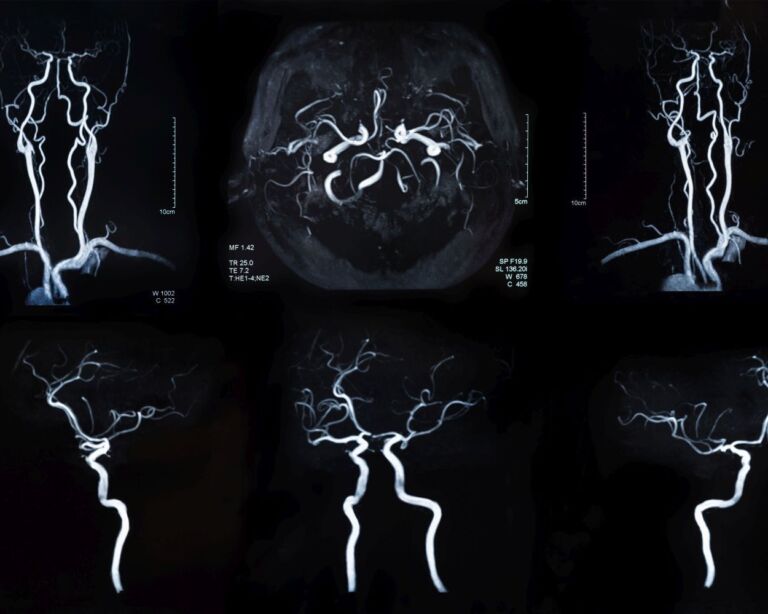Overview: What is an aortic rupture?
In an aortic rupture, the vessel wall of the main artery – the aorta – tears. This puts those affected in a life-threatening condition. Medical staff must recognize and treat the aortic tear as soon as possible, otherwise there is a risk of rapid death. An aortic rupture is characterized by a sudden, very severe pain in the region of the chest, upper abdomen or back. Some affected persons lose consciousness and faint. Doctors must close the tear in the aorta immediately as part of an operation or intervention, otherwise the chances of survival are low due to the often massive bleeding.
An aortic rupture is a real emergency in which you must call an emergency doctor immediately on 144. Even a small tear can quickly lead to considerable internal bleeding. Patients do not normally survive a complete rupture of the aorta.
The causes are either existing diseases of the aorta, such as a splitting of the vessel wall (aortic dissection), or a bulging of the aorta (aortic aneurysm) – this can burst. Blunt trauma can also lead to an aortic rupture, for example if the rib cage hits a hard surface at high speed in a car accident.
Anatomical structure of the aortic wall and segmental sections of the aorta
The aorta (main artery) is the central and largest artery in the body, which runs from the left ventricle in an arc through the chest. It has three wall layers:
- Inner layer (intima) with vascular cells
- Middle layer (media or tunica media) with muscle cells
- Outer layer (adventitia or tunica externa) with connective tissue
The aorta has many branches in various parts of the body and supplies them with blood, oxygen and nutrients: Head, arms, abdomen (where it branches off into the pelvic vessels), liver, spleen, intestines and kidneys. Diseases of the aorta can significantly impair the function of many organs.
The aorta can be roughly divided into the following sections:
- Aorta ascendens: The ascending section of the aorta that starts from the left ventricle. The beginning lies within the pericardium. Two branches branching off from it supply the heart muscle.
- Aortic arch (Arcus aortae): The second section begins at the point where the aorta passes through the pericardium. The aorta bends upwards and diagonally backwards to the left. Three outgoing branches supply the arms, head and neck.
- Aorta descendens: The descending branch of the main artery first runs through the chest cavity (thoracic aorta, supplies the lungs and chest wall, for example), then passes through the diaphragm and finally reaches the abdominal cavity (abdominal aorta, supplies the abdominal organs). At the end, the aorta branches into the two iliac arteries, which in turn supply the pelvis and legs with blood.
There are two different causes of aortic rupture: existing diseases of the aorta and trauma, for example due to an accident.
Aortic rupture: Causes are diseases or injuries
Spontaneous aortic rupture: diseases of the aorta as causes
Degenerative changes in the vessel wall are often responsible for aortic rupture. The vessels “wear out” with increasing age – experts call this process vascular calcification or arteriosclerosis. This can lead to an aortic dissection, in which the three wall layers of the aorta split open and bleeding occurs. The blood normally only flows along the innermost vascular layer. Due to the splitting, it also gets between the middle and outer vascular layer. The bleeding weakens the structure of the vessel wall, it expands and can eventually tear. The thoracic aorta is often affected.
The aortic aneurysm is the most common cause of aortic rupture. The main artery has bulges, usually in the area of the abdominal aorta, which become larger over time and can eventually burst. This quickly leads to internal bleeding, which in turn is life-threatening.
Traumatic aortic rupture: massive injuries as causes
Traumatic aortic rupture is also known. If extreme forces act on the aorta, it can rupture. This often happens in an accident involving a car, motorcycle, airplane or when a car collides with a pedestrian. The chest often bounces at high speed. Even when falling from a great height, enormous forces act on the body on impact. As a rule, not only the aorta is damaged, but also other organs. This is referred to as a polytrauma.
If all three wall layers of the aorta rupture, there is a complete or free aortic rupture. A person does not survive this because the blood can flow unhindered into the chest or abdominal cavity – you bleed to death. In the case of a covered rupture, the outer layer – the adventitia – remains intact. The blood seeps only slightly into the chest or abdominal cavity and a bruise (hematoma) forms. If surgery is performed immediately, those affected can survive.
Symptoms: Aortic rupture causes severe pain
The symptoms of an aortic rupture are sudden severe pain in the chest or abdominal region. The pain is so severe that many describe it as “annihilation pain”. It can also radiate to other areas of the body, such as the back, shoulder or groin region. There are also other symptoms such as
- Rapid drop in blood pressure and pulse due to massive bleeding in the chest or abdomen (shock)
- Rapid heartbeat (tachycardia)
- Shortness of breath (dyspnea)
- Pain in other areas of the body if the bruise presses on neighboring organs, for example in the abdomen
- Neurological disorders: Loss of sensitivity or signs of paralysis – the bruise presses on the nerves
- Circulatory problems up to circulatory collapse
- Unconsciousness and fainting – the brain is no longer supplied with sufficient blood and oxygen.
Other organs are also damaged when the body’s blood supply collapses. Aortic rupture, for example in the case of a known aortic aneurysm, is an absolute emergency in which you must call an emergency doctor immediately. Rapid diagnosis and treatment are important to improve the chances of survival.
Aortic rupture: Diagnosis with us
It is important that emergency physicians diagnose and treat the aortic rupture as quickly as possible – otherwise the prognosis is unfavorable. The patient is examined physically and asked about his or her symptoms, provided he or she is responsive. The first indication of an aortic rupture is sudden, extremely severe pain in the chest or abdomen. Further information is available:
- Differences in blood pressure between the arms and legs or between both arms
- Pale skin, mostly lower extremities due to lack of blood circulation
- Weakened breath sounds
- Unconsciousness
If the suspicion of an aortic rupture is confirmed, we quickly apply imaging procedures:
- Computed tomography (CT)
- Optional ultrasound examination (sonography)
Aortic rupture – various degrees of severity
We classify aortic tears into different degrees of severity. The treatment strategy and prognosis also depend on this:
- Grade 1: Only the innermost layer (intima) is torn.
- Grade 2: A bruise (hematoma) has formed in the vessel wall.
- Grade 3: Blood has leaked through the injured vessel wall and a hematoma has formed around the blood vessel. We speak of a “false aneurysm” or “pseudoaneurysm”.
- Grade 4: The vessel wall is completely torn.
Aortic rupture: prevention, early detection, prognosis
Aortic rupture can have various causes. Diseases of the aorta such as aneurysms are often to blame when the aorta tears. One example is abdominal aortic aneurysm, for which there are certain measures for early detection and prevention:
- Early detection of an abdominal aortic aneurysm using ultrasound is recommended in Switzerland for high-risk patients aged 65 and over, for example smokers. However, you will have to pay for the examination yourself.
- Intervention or surgery can reduce the risk of abdominal aortic rupture and the risk of bleeding. The risk of a rupture increases with a size of more than 5.5 centimeters in men and 5 centimeters in women. As a rule, the risk of impending aortic rupture is greater than the risks and complications associated with the intervention or surgery. It is therefore always important to weigh up the pros and cons carefully with your doctor.
Preventing aortic rupture: a healthy lifestyle protects the blood vessels
In the case of an aneurysm, vascular calcification (arteriosclerosis) and high blood pressure (hypertension) play a special role. You can prevent both to a certain extent by leading a healthy lifestyle. Some tips:
- Refrain from smoking. And if you smoke, try to stop smoking. Seek professional support if you can’t do it alone.
- A healthy diet also helps the blood vessels. Eat plenty of fruit, vegetables and wholegrain products.
- Get enough exercise in your everyday life and take part in sport.
- Drink as little alcohol as possible. Take regular alcohol breaks every week.
- Ensure a healthy body weight. Avoid overweight and obesity. If you are overweight, try to lose a few kilos. The best recipe for this is a combination of a healthy diet and plenty of exercise.
And finally: Have high blood pressure and elevated blood lipids adequately treated with medication if a healthy lifestyle does not bring sufficient success.
Course and prognosis of aortic rupture
Spontaneous aortic rupture is life-threatening and must be treated immediately. Internal bleeding in the abdominal or chest cavity costs many sufferers their lives. The course and prognosis also depend on whether the outer vascular layer – the adventitia – remains intact. The location and size of the crack also play a role in the prognosis. If the emergency doctor makes the diagnosis quickly and begins treatment, the person concerned has a realistic chance of survival. A complete rupture of the aorta, in which all three layers of the wall are torn, usually leads to immediate death – those affected cannot survive this injury.
In the case of a traumatic aortic rupture, the course and prognosis are also often unfavorable. This is because other organs are often damaged by the accident. The prognosis also depends on the severity of these concomitant injuries. Such polytrauma can cost the lives of many injured people.
Aortic rupture: treatment must begin quickly!
Aortic rupture is always an emergency that requires intensive medical treatment. Call an emergency doctor immediately! The aim of treatment is first to stabilize the affected person and then to close the aortic tear as quickly as possible by means of an intervention. This is the only way those affected have a chance of survival. But many die due to the aortic rupture. In case of a surgical intervention, the Institute of Anesthesiology will select the anesthesia procedure that is individually adapted to you.

